

Back to Telementoring
From: Cassandra Lange
My name is Cassandra Lange and I am a 12 year old Middle School Student in Arcadia California. I am doing a science project on Memory and found your website. It was very helpful to me. Do you know any other resources, either websites, or books or other publications which would deal specfically with the difference between remembering things you hear vs. remembering things you see? Thank you for your help.
Cassandra Lange
Foothills Middleschool
-------------------------------------------------------------
Dear Cassandra,
I suggest you conduct your project in terms of local changes in neuronal activity that occurs during different states of information processing. It is known that areas of the brain that play a role in sensory information such as seeing and hearing are also important in remembering things such as objects and words.
Performing language tasks (generating verbs, speaking, hearing and seeing words) involve different areas of the brain, one is the articulatory area of the left frontal area of cortex, the so-called Broca’s area (part of the motor cortex responsible for commanding the muscles for speech), and the other are areas related to the perception. For instance, if you are hearing a word, then you activate the temporal auditory cortex and the frontal cortex. If you are writing a word you will activate the occipital area (visual cortex - because you are seeing it) and Broca’s area. Why is the Broca's area also involved in a written word if you are not speaking? It is because the origins of our language lie in the speech. When we were primitive man and woman we had only speech. Therefore, written language also uses the same area of the brain. When we think to speak or read, we will see that the motor area also will activate as we were speaking in silence.
Related to visual memory, a new study with PET (medical device that takes images of the functioning brain) has shown that an area of the brain that plays a role in vision is also important in remembering objects, scenes, and distances. Results of the scanning showed activity in Area 17 of the brain, part of the visual cortex, as volunteers recalled the images (Science 1999;284:167-170).
I also suggest you illustrate your
work with related images. I have attached a very good image for you.
If you decide to use that image, you
should ask permission to Dr. Mudd (peter@imaging.wustl.edu). It is called
"Imagens of Mind In: The Neuro Imaging Laboratory - Washington University
School of Medicine.

Also, see in another image where are
located the frontal, temporal and occipital cortex in Brain & Mind
page:
http://www.epub.org.br/cm/n01/arquitet/lobos_i.htm
See the PET device and some more PET
scan images in Brain & Mind page:
http://www.epub.org.br/cm/n01/pet/pet.htm
Explore some more good links on memory
for general public:
http://www.exploratorium.edu/memory/links.html
Finally, here are tips on how to write
a successful Science Fair Project:
http://faculty.washington.edu/chudler/fair.html
Please, give me a feedback of what you have done. I would appreciate to see your schoolwork.
Regards,
Dr. Cardoso
Copyright Silvia Helena Cardoso, PhD